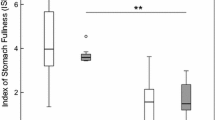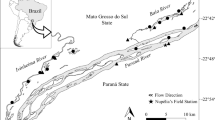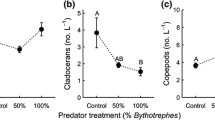Abstract
Fish predation was tested as a factor mediating the coexistence of Daphnia taxa in the shallow, hypertrophic Lake Blankaart. Naturally co-occurring populations of D. galeata and the hybrid D. galeata x cucullata were subjected to different levels of fish predation in in situ enclosures. In control enclosures without fish, the largest taxon D. galeata rapidly became dominant over the intermediate sized D. galeata x cucullata, mainly as a result of higher birth rates. In enclosures with fish, population densities of D. galeata dropped relative to D. galeata x cucullata, due to higher mortality rates. These results are in concordance with the ‘temporal hybrid superiority hypothesis’, and can be explained by a higher vulnerability of the large and more conspicuous D. galeata to the size selective predation exerted by visually hunting planktivorous fishes. After approximately one month, however, population growth rates of D. galeata and D. galeata x cucullata in the enclosures with fish converged, due to a relative reduction in the mortality rate of D. galeata. This suggests that, in the presence of fish, D. galeata may co-exist with hybrids due to a decrease in its relative vulnerability to visual predation with time. Indeed, both D. galeata and the hybrid showed strong reductions in adult body size in the enclosures with fish, but this size reduction tended to be stronger in D. galeata than in D. galeata x cucullata. In addition, turbidity increased in the enclosures with fish and may additionally have reduced the relative advantage of D galeata x cucullata with regard to mortality caused by visual predation.
Access this chapter
Tax calculation will be finalised at checkout
Purchases are for personal use only
Preview
Unable to display preview. Download preview PDF.
Similar content being viewed by others
References
Barton, N. H. & G. M. Hewill, 1985. Analysis of hybrid zones. Ann. Rev. Ecol. Syst. 16: 113–148.
Barton, N. H. & G. M. Hewitt, 1989. Adaptation, speciation and hybrid zones. Nature 341: 497–503.
Bierne, N., P. David, P. Boudry & F. Bonhomme, 2002. Assortative fertilization and selection at larval stage in the mussels Mytilus edulis and M. gallopwvincialis. Evolution 56: 292–298.
Boersma, M. & J. Vijverberg, 1994a. Resource depression in Daphnia galeata, Daphnia cucullata and their interspecific hybrid: life history consequences. J. Plankton Res. 16: 1741–1758.
Boersma, M. & J. Vijverberg, 1994b. Seasonal variations in the condition of two Daphnia species and their hybrid in a eutrophic lake: evidence for food limitation. J. Plankton Res. 16: 1793–1809.
Boersma, M. & J. Vijverberg, 1995. The significance of nonviable eggs for Daphnia population dynamics. Limnol. Oceanogr. 40: 1215–1224.
Boersma, M., 1995. Competition in natural populations of Daphnia. Oecologia 103: 309–318.
Boersma, M., P. Spaak & L. De Meester, 1998. Predator-mediated plasticity in morphology, life history, and behavior of Daphnia: the uncoupling of responses. Am. Nat. 152: 237–248.
Botrell, H. H., A. Duncan, Z. M. Gliwicz, E. Grygierek, A. Herzig, A. Hillbricht-Ilkowska, H. Kurasawa, P. Larsson & T. Weglenska, 1976. A review of some problems in Zooplankton production studies. Norwegian J. Zool. 24: 419–456.
Declerck, S. & A. Weber, 2003. Genetic differentiation in life history between D. galeata populations: an adaptation to local predation regimes? J. Plankton Res. 25: 93–102.
Flössner, D. & K. Kraus, 1986. On the taxonomy of the Daphnia hyalina-galeata complex (Crustacea: Cladocera). Hydrobiologia 137:97–115.
Gliwicz, Z. M. & G. Umana, 1994. Cladoceran body size and vulnerability to copepod predation. Limnol. Oceanogr. 39: 419–424.
Good, T. P., J. C. Ellis, C. A. Annett & R. Pierotti, 2000. Bounded hybrid superiority in an avian hybrid zone: effects of mate, diet, and habitat choice. Evolution 54: 1774–1783.
Müller, J. & A. Seitz, 1993. Habitat partitioning and differential vertical migration of some Daphnia genotypes in a lake. Archiv für Hydrobiol. Beih. Ergebnisse der Limnol. 39: 167–174.
Moore, W. S. & W. D. Koenig, 1986. Comparative reproductive success of yellow-shafted, red-shafted, and hybrid flickers across a hybrid zone. The Auk 103: 42–51.
Paloheimo, J. E., 1974. Calculation of instantaneous birth rate. Limnol. Oceanogr. 19: 692–694.
Schwenk, K. & P. Spaak, 1995. Evolutionary and ecological consequences of interspecific hybridization in cladocerans. Experientia 51:465–481.
Schwenk, K., 1997. Evolutionary genetics of Daphnia species complexes — Hybridism in syntopy. PhD-thesis.
Spaak, P. & J. R. Hoekstra, 1995. Life history variation and the coexistence of a Daphnia hybrid with its parental species. Ecology 76: 553–564.
Spaak, P. & J. R. Hoekstra, 1997. Fish prédation on a Daphnia hybrid species complex: a factor explaining species coexistence? Limnol. Oceanogr. 42: 753–762.
Spaak, P., J. Vanoverbeke & M. Boersma, 2000. Predator-induced life-history changes and the coexistence of five taxa in a Daphnia species complex. Oikos 89: 164–174.
Taylor, D. J. & P. D. N. Hebert, 1992. Daphnia galeata mendotae as a cryptic species complex with interspecific hybrids. Limnol. Oceanogr. 37: 658–665.
Taylor, D. J. & P. D. N. Hebert, 1993. A reappraisal of phenotypic variation in Daphnia galeata nwndotae: the role of interspecific hybridization. Can. J. Fish, aquat. Sci. 50: 2137–2146.
Tollrian, R. & C. D. Harvell (eds), 1999. Ecology and Evolution of Inducible Defences. Princeton University Press, Princeton, New Jersey.
Vanni, M. J. & C. D. Layne, 1997. Nutrient recycling and herbivory as mechanisms in the ‘top-down’ effect of fish on algae in lakes. Ecology 78: 21–40).
Van der Werf, B., J. Schrotenboer, A. F. Richter, J. R. Moed, H. L. Hoogveld & H. De Haan, 1987. A durable and transportable limnetic enclosure system suitable for wind-exposed lakes. Can. J. Fish, aquat. Sci. 44: 1649–1652.
Weider, L. J., 1993. Niche breadth and life history variation in a hybrid Daphnia complex. Ecology 74: 935–943.
Weisse, T., H. Müller, M. Pinto-Coelho, A. Schweizer, D. Springmann & G. Baidinger, 1990. Response of the microbial loop to the phytoplankton spring bloom in a large pre-alpine lake. Limnol. Oceanogr. 35: 781–794.
Wolf, H. G. & M. A. Mort, 1986. Interspecific hybridisation underlies phenotypic variability in Daphnia populations. Oecologia 68:507–511.
Author information
Authors and Affiliations
Editor information
Editors and Affiliations
Rights and permissions
Copyright information
© 2003 Springer Science+Business Media Dordrecht
About this chapter
Cite this chapter
Declerck, S., De Meester, L. (2003). Impact of fish predation on coexisting Daphnia taxa: a partial test of the temporal hybrid superiority hypothesis. In: Martens, K. (eds) Aquatic Biodiversity. Developments in Hydrobiology, vol 171. Springer, Dordrecht. https://doi.org/10.1007/978-94-007-1084-9_5
Download citation
DOI: https://doi.org/10.1007/978-94-007-1084-9_5
Publisher Name: Springer, Dordrecht
Print ISBN: 978-94-010-3785-3
Online ISBN: 978-94-007-1084-9
eBook Packages: Springer Book Archive




